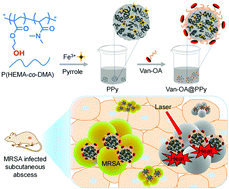Our official English website, www.x-mol.net, welcomes your feedback! (Note: you will need to create a separate account there.)
In vivo photothermal inhibition of methicillin-resistant Staphylococcus aureus infection by in situ templated formulation of pathogen-targeting phototheranostics
Nanoscale ( IF 6.7 ) Pub Date : 2020/03/09 , DOI: 10.1039/d0nr00181c Xujuan Guo 1, 2, 3, 4, 5 , Bing Cao 1, 2, 3, 4, 5 , Congyu Wang 1, 2, 3, 4, 5 , Siyu Lu 5, 6, 7, 8 , Xianglong Hu 1, 2, 3, 4, 5
Nanoscale ( IF 6.7 ) Pub Date : 2020/03/09 , DOI: 10.1039/d0nr00181c Xujuan Guo 1, 2, 3, 4, 5 , Bing Cao 1, 2, 3, 4, 5 , Congyu Wang 1, 2, 3, 4, 5 , Siyu Lu 5, 6, 7, 8 , Xianglong Hu 1, 2, 3, 4, 5
Affiliation

|
Bacterial infection has caused a serious threat to human public health. Methicillin-resistant Staphylococcus aureus (MRSA) is a representative drug-resistant bacterium, which is difficult to eradicate completely, resulting in high infection probability with severe mortality. Herein, pathogen-targeting phototheranostic nanoparticles, Van-OA@PPy, are developed for efficient elimination of MRSA infection. Van-OA@PPy nanoparticles are fabricated from the in situ templated formation of polypyrrole (PPy) in the presence of ferric ions (Fe3+) and a polymer template, hydrophilic poly(2-hydroxyethyl methacrylate-co-N,N-dimethyl acrylamide), P(HEMA-co-DMA). PPy nanoparticles are further coated with vancomycin conjugated oleic acid (Van-OA) to afford the resultant pathogen-targeting Van-OA@PPy. A high photothermal conversion efficiency of ∼49.4% is achieved. MRSA can be efficiently killed due to sufficient nanoparticle adhesion and fusion with MRSA, followed by photothermal therapy upon irradiation with an 808 nm laser. Remarkable membrane damage of MRSA is observed, which contributes greatly to the inhibition of MRSA infection. Furthermore, the nanoparticles have high stability and good biocompatibility without causing any detectable side effects. On the other hand, residual Fe3+ and PPy moieties in Van-OA@PPy endow the nanoparticles with magnetic resonance (MR) imaging and photoacoustic (PA) imaging potency, respectively. The current strategy has the potential to inspire further advances in precise diagnosis and efficient elimination of MRSA infection in biomedicine.
中文翻译:

以病原体为靶标的光热原位原位模板制剂在体内光热抑制耐甲氧西林的金黄色葡萄球菌感染
细菌感染已严重威胁人类公共健康。耐甲氧西林金黄色葡萄球菌(MRSA)是一种代表性的耐药细菌,难以完全根除,导致感染几率高,死亡率高。在此,针对病原体的光热敏纳米粒子Van-OA @ PPy被开发出来,以有效消除MRSA感染。Van-OA @ PPy纳米粒子是在铁离子(Fe 3+)和聚合物模板,亲水性聚(甲基丙烯酸2-羟乙酯-co-N,N-二甲基)存在下原位模板化聚吡咯(PPy)制备而成的丙烯酰胺),P(HEMA- co-DMA)。PPy纳米颗粒进一步用万古霉素共轭油酸(Van-OA)包衣,以提供最终的靶向病原体的Van-OA @ PPy。实现了约49.4%的高光热转换效率。由于足够的纳米颗粒粘附和与MRSA的融合,可以有效地杀死MRSA,然后在用808 nm激光照射后进行光热疗法。观察到MRSA的明显膜损伤,这极大地抑制了MRSA感染。此外,纳米颗粒具有高稳定性和良好的生物相容性,而不会引起任何可检测到的副作用。另一方面,残留的Fe 3+Van-OA @ PPy中的Py和PPy部分分别赋予纳米颗粒磁共振(MR)成像和光声(PA)成像效能。当前的策略有可能激发精确诊断和有效消除生物医学中MRSA感染的进一步进展。
更新日期:2020-04-09
中文翻译:

以病原体为靶标的光热原位原位模板制剂在体内光热抑制耐甲氧西林的金黄色葡萄球菌感染
细菌感染已严重威胁人类公共健康。耐甲氧西林金黄色葡萄球菌(MRSA)是一种代表性的耐药细菌,难以完全根除,导致感染几率高,死亡率高。在此,针对病原体的光热敏纳米粒子Van-OA @ PPy被开发出来,以有效消除MRSA感染。Van-OA @ PPy纳米粒子是在铁离子(Fe 3+)和聚合物模板,亲水性聚(甲基丙烯酸2-羟乙酯-co-N,N-二甲基)存在下原位模板化聚吡咯(PPy)制备而成的丙烯酰胺),P(HEMA- co-DMA)。PPy纳米颗粒进一步用万古霉素共轭油酸(Van-OA)包衣,以提供最终的靶向病原体的Van-OA @ PPy。实现了约49.4%的高光热转换效率。由于足够的纳米颗粒粘附和与MRSA的融合,可以有效地杀死MRSA,然后在用808 nm激光照射后进行光热疗法。观察到MRSA的明显膜损伤,这极大地抑制了MRSA感染。此外,纳米颗粒具有高稳定性和良好的生物相容性,而不会引起任何可检测到的副作用。另一方面,残留的Fe 3+Van-OA @ PPy中的Py和PPy部分分别赋予纳米颗粒磁共振(MR)成像和光声(PA)成像效能。当前的策略有可能激发精确诊断和有效消除生物医学中MRSA感染的进一步进展。


























 京公网安备 11010802027423号
京公网安备 11010802027423号